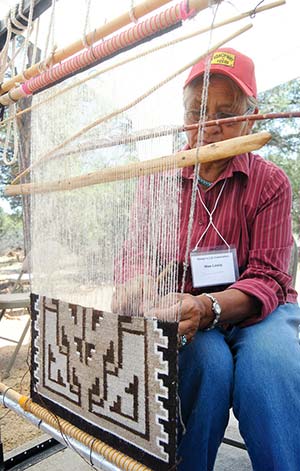Workshops, show unlock secrets of wool
By Shondiin Silversmith
Navajo Times
TSAILE, Ariz., June 30, 2011
CANYON de CHELLY NATIONAL MONUMENT, Ariz., June 10, 2011


(Times photos - Leigh T. Jimmie)
TOP: Edith Simonson displays her natural dyed wool at the Sheep is Life Celebration June 25 at Diné College in Tsaile, Ariz.
BOTTOM: Mae Lewis, of Sanostee, N.M., demonstrates weaving at the Sheep is Life Celebration June 25 at Diné College in Tsaile, Ariz.
From the rodeo grounds to the museum, programs, workshops, exhibits and shows invited admirers of ovine beauty and utility to discover something new.
The annual Sheep is Life festival focuses on the Churro breed, first introduced to the area by Spanish settlers over 400 years ago and quickly embraced by the Navajo people.
Once the traditional breed raised by Navajos, the Churro almost disappeared by the late 20th Century as new breeds were introduced to accomplish first one, then another goal to improve the prices Navajos got for their mutton and wool.
But then a group of Navajos got together and dedicated themselves to reviving interest in, and respect for, the hardy little animals. Organizing themselves under the banner Diné be' Iiná Inc. (the Navajo Lifeway), the group sponsors a variety of efforts, led by the annual Sheep is Life celebration.
Churro wool is used throughout the celebration in different demonstrations of weaving, carding as well as spinning. It is preferred by many weavers for the yarn that comes from its long, silky strands.
Sash belt weaver Anderson Hoskie of Gallup has been attending the Sheep is Life celebration for 10 years.
He demonstrates his art to spectators and workshop participants, showing them the techniques for making this important piece of clothing traditionally worn by Navajo men and women.
Hoskie said he has been weaving sash belts for over 15 years.
Demonstrations of carding and spinning were performed by Betty Billy of Sanostee, N.M., while Mae Lewis sat at a loom and entranced onlookers with the rhythmic movement of her hands.
Lewis, who said she's been weaving since she was 7 years old, was creating a rug in the soothing natural colors and complex geometric forms of the Two Grey Hills style.
The two women have been attending the Sheep is Life celebration for the past two years and enjoy sharing their skills with an appreciative audience.
Pound for pound, the greatest amount of wool was found at the wool show, a juried show of raw fleeces.
There were four judges and each knew what they were looking for: "The breed character of the Navajo Churro as well as the quality of the wool," said judge Colleen Biakeddy, vice president of Diné be' Iiná.
The other three judges were Sharon Begay, resident life manager at Diné College; Jay Begay Jr., youth counselor and official sheep inspector; and DBI adviser Connie Taylor.
"I just love playing with wool," said Sharon Begay, noting that they had received training in wool workshops at Utah State University.
"We went to several different places. We got to see different flocks and wool," added Jay Begay Jr.
According to DBI advisor and workshop teacher Cindy Dvergsten, roughly a fourth of the wool show entries this year were from Navajos.
"The animal show is more popular," she said.
"The idea is to get more people involved with handling wool," said Dvergsten, who last year shared the prize for Reserve Grand Champion ewe fleece with husband Mike Rich.
The fleeces were presented in six categories, divided by the gender of the animal and whether they were white or colored. The other two categories were for the hogget, or first shearing from a lamb, also divided by ram (male) and ewe (female).
First, second, and third place winners were named in each category, based on the quality and weight of the fleece.
Each entry was submitted inside a bag, and as the judges were stretching, touching, smelling, and digging through the wool, they presented basic facts about it.
Taylor said when a fleece is greasy, it's due to a high protein and grain diet for the animal.
Each judge evaluated the amount of stretch in the wool, its luster, and the "handle" of the fleece.
Echoing Taylor's comment, Biakeddy said when you stretch raw wool you're able to tell the biological makeup of the fleece.
After ribbons were given to the winners, the judges named Grand Champion and Reserve Grand Champion ewe and ram fleeces from among the first place winners.
This year Robbin Robinson, who entered several fleeces, won the Grand Champion award for a white ewe fleece. Robinson said she was glad one of her bags of wool won something.
Mike Cutler won Grand Champion for his colored ram's wool. Cutler said that even though he purchased the ram and so couldn't take credit for its breeding, it felt great to win.
Dvergsten again won a Reserve Grand Champion award, this time for a ram's fleece.
"It feels good to be moving up in this category," she said. "I feel really good because it took me a long time to get a good ram."
Taylor said the judges all felt that Cutler and Robinson deserved the top awards, adding, "I think the participants did to."
Sheep is Life is co-sponsored by the Diné College Land Grant Program and funded in partnership with the USDA Risk Management Agency.
Information: www.navajolifeway.org.

